May 15, 2009
Arctic Cooling has Begun
By Peter Taylor
What follows is the first guest post on Talking About The Weather. I chose Peter Taylor’s short essay on the Arctic out of respect for Peter’s research, his calm during intense debates, and the focus he brings to the issues. As Peter makes clear, those “banking” on rapid Arctic sea ice deterioration in the decades ahead seem to know very little about climate cycles. Harold Ambler
I hope to be around in 2020, when some have suggested those of us on the sceptics’ side should have been vindicated, but I think we will prevail much sooner. The Arctic heat-wave of 1920-1940 is of course well-known to real Arctic climate scientists. I reviewed 32 temperature data sets for Arctic stations to 2004 some with very long records. In 2006 I could find only one with higher temperatures in 2004 than in the late 1930s or early 1940s - that was on the eastern coast of Greenland. Fear-mongering regarding Arctic sea ice is the most acute of all that brought forward by global warming doomsayers.
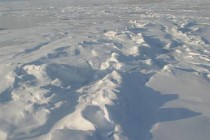
Image courtesy of the USGS.
Since then I have reviewed dozens of papers on surface air temperature, sea surface temperatures, ice-mass, glacier speeds and sea-ice, and all show a clear cyclic pattern of roughly 70 years. Some Greenland and Alaskan temperatures peaked in 2006-2008, but the pattern looks set to repeat. The latest Arctic heat wave is not identical to the last - firstly it is higher, by maybe 20% in some places, and secondly, the hot-spots are different. But one thing is clear - it is driven by two distinctive factors - a 14% increase in clouds over the North Pole and Beaufort Sea between 1980-2000, and the incursion of warm Atlantic water under the ice and into the Beaufort Gyre. The rapid summer ice loss is due to melting from above (infra red from the clouds) and below (warm Atlantic water).
The strength of the Beaufort Gyre determines how far Atlantic water penetrates the Arctic - when the Pacific Decadal Oscillation is warm and Alaskan Shelf winds are low, the gyre weakens and may reverse flow; when cold (as it has been since late 2006), the Alaskan interior cools, the winds strengthen and the gyre strengthens accordingly - there is a lag of a few years.
Thus, this domino effect from the Pacific will eventually reach the area between Greenland and Norway and summer sea-ice ought to return to the long-term norm (unless there really is a strong greenhouse element - which I can't see it greater than the difference between this warm period and the last - i.e. about 20%) and unless there is an even steeper decline in global temperatures due to the quiet sun effect.
On the latter - there is a body of evidence that during quiet solar periods, the jetstream is shifted along with Arctic pressure systems that lead to blocking high pressure over Iceland - sending the jetstream further south and cooling western Europe. The eastern seaboard of the USA gets a little warmer, but the mid-West suffers late springs, dry summers, and bitter winters - not good for the breadbasket of the world! We should get to see this play out over the next five years. See post on Harold Ambler's Talking about the Weather site here. H/T Climate Depot.
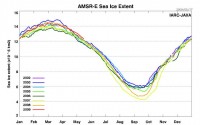
See larger here.
May 14, 2009
Will Anybody Notice Global Cooling
By Norm Kalmanovitch, Friends of Science
It is inconceivable that even after a decade since global warming ended and seven years into a cooling trend with no end of cooling in sight, that world leaders are unaware of these facts and are still pursuing initiatives to stop global warming. Something is terribly wrong with the official international science bodies such as the IPCC who have not come forward and properly informed the world leaders of current global temperatures.
Something is terribly wrong with the individual government science bodies who did not come forward and inform their own leaders when it was certain that global warming had ended, or when there was sufficient data to claim that we are now in a cooling trend. It is not as though this is highly guarded secret data that can only be accessed by a limited group of people. The global temperature data is in fact readily available from several public sites and can be downloaded at no cost.
For the past year Friends of Science has been maintaining a graph of satellite temperature data and atmospheric CO2 concentration data on their website. This graph is updated every month as the new data becomes available. The cooling trend that started in 2002 is highlighted by a straight line best fit posted on this graph. The numerical value for this trend is 0.25C/decade of cooling!
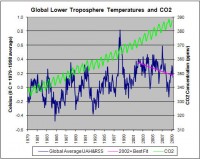
By contrast the forcing parameter of the IPCC climate models would dictate that the effect of the 10ppmv increase in CO2 should cause a temperature increase of 0.15C/decade. If in fact there is any validity to the claims of CO2 increases causing warming; the fact that we are cooling at twice the rate that the climate models say we should be warming, is a clear indication that natural forces are about three times stronger than the maximum possible effects from CO2 increases.
Quantum physics clearly demonstrates that the effect of current increases in CO2 can have only a small and diminishing effect on global temperature with further increases in concentration. Since the natural effects dominate, and physics dictates that the effect of increasing emissions is only a small fraction of the effect commonly accepted; it is clear that any initiatives aimed at reducing CO2 emissions for the purpose of reducing global warming are entirely without merit and serve no purpose whatsoever.
This is not a trivial issue because these initiatives to stop global warming have caused great suffering to the poorest people of the world. Biofuel initiatives have caused a global food crisis as food crops were forced to compete with biofuel crops driving the price of basic food staples beyond the means of the poor. The attempt to replace inexpensive coal fired power plants with very expensive and unreliable alternate energy sources such as wind power, has raised the cost of power not only affecting the poor, but also industry further reducing the ability to compete with countries using inexpensive power to manufacture products.
Unfortunately the AGW concept is so engrained in the public psyche through the graphic propaganda of the last several years that all verbal arguments against this ideology fall on deaf ears, and get shouted down by an indoctrinated crowd. While these people are deaf they are not blind, and no matter how loud the shouting, a graphic representation of increasing CO2 and decreasing global temperatures will be seen above the din.
If every presentation contained a graph similar to the one on the Friends of Science website this “visual” will eventually get in front of leaders who will be forced to reconsider the global warming initiatives that have been so costly to the world.
Icecap Note: Below is a plot of the average of the satellite and the Hadley Center global monthly temperatures versus the monthly seasonally adjusted CO2 from NOAA ESRL since 2002. Note the clear downtrend in temperatures even as CO2 continues to rise.
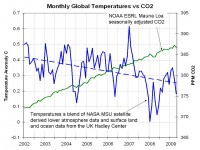
Larger image here.
May 09, 2009
Have Changes In Ocean Heat Falsified The Global Warming Hypothesis?
By William DiPuccio on Climate Science
The Global Warming Hypothesis
Albert Einstein once said, “No amount of experimentation can ever prove me right; a single experiment can prove me wrong.” Einstein’s words express a foundational principle of science intoned by the logician, Karl Popper: Falsifiability. In order to verify a hypothesis there must be a test by which it can be proved false. A thousand observations may appear to verify a hypothesis, but one critical failure could result in its demise. The history of science is littered with such examples.
A hypothesis that cannot be falsified by empirical observations, is not science. The current hypothesis on anthropogenic global warming (AGW), presented by the U.N.’s Intergovernmental Panel on Climate Change (IPCC), is no exception to this principle. Indeed, it is the job of scientists to expose the weaknesses of this hypothesis as it undergoes peer review. This paper will examine one key criterion for falsification: ocean heat.
Ocean heat plays a crucial role in the AGW hypothesis, which maintains that climate change is dominated by human-added, well-mixed green house gasses (GHG). IR radiation that is absorbed and re-emitted by these gases, particularly CO2, is said to be amplified by positive feedback from clouds and water vapor. This process results in a gradual accumulation of heat throughout the climate system, which includes the atmosphere, cryosphere, biosphere, lithosphere, and, most importantly, the hydrosphere. The increase in retained heat is projected to result in rising atmospheric temperatures of 2-6C by the year 2100.
In 2005 James Hansen, Josh Willis, and Gavin Schmidt of NASA coauthored a significant article (in collaboration with twelve other scientists), on the “Earth’s Energy Imbalance: Confirmation and Implications” (Science, 3 June 2005, 1431-35). This paper affirmed the critical role of ocean heat as a robust metric for AGW. “Confirmation of the planetary energy imbalance,” they maintained, “can be obtained by measuring the heat content of the ocean, which must be the principal reservoir for excess energy” (1432).
In 2007 Roger Pielke, Sr. suggested that ocean heat should be used not just to monitor the energy imbalance in the climate system, but as a “litmus test” for falsifying the IPCC’s AGW hypothesis (Pielke, “A Litmus Test”, climatesci.org, April 4, 2007).
A comparison of these projections to observed data is shown below. Despite expectations of warming, temperature measurements of the upper 700m of the ocean from the ARGO array show no increase from 2003 through 2008. Willis calculates a net loss of -0.12 (plus or minus 0.35) x 1022Joules per year (Pielke, Physics Today,55) from mid-2003 to the end of 2008 (Dr. Pielke received permission from Josh Willis to extend the ARGO data to the end of 2008).
According to a recent analysis of ARGO data by Craig Loehle, senior scientist at the Illinois-based National Council for Air and Stream Improvement, the loss is -0.35 (plus or minus 0.2) x 1022Joules per year from mid-2003 to the end of 2007 (see Loehle, 2009: “Cooling of the global ocean since 2003.” Energy & Environment, Vol. 20, No. 1&2, 101-104(4)). Loehle used a more complex method than Willis to calculate this trend, enabling him to reduce the margin of error.
My calculations for observed global heat, shown below, are based on observed upper ocean heat. Since upper ocean heat is calculated to be 80% of the global total, observed global heat equals approximately 125% (1/0.8) of the observed upper ocean heat.
PROJECTED vs. OBSERVED HEAT ACCUMULATION, 2003-2008 (6 YEARS)
Model
Projected Global Heat Accumulation
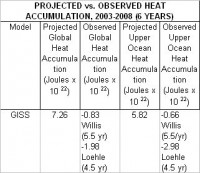
Heat Deficit. The graph below shows the increasing deficit of upper ocean heat from 2003 through 2008 based on GISS projections by Hansen, Willis, Schmidt, et. al. Actual heat accumulation is plotted from observed data (using ARGO) and shows the overall linear trend (after Willis and Loehle). Seasonal fluctuations and error bars are not shown.
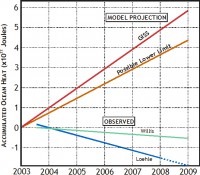
Read full post here.
May 04, 2009
AARI Predicts Arctic Cooling/Ice Recovery To Continue
By Joseph D’Aleo (h/t to Dr. Gary Sharp)
Arctic ice extent bottomed out in 2007, and has recovered the last two years as shown by this graph from the University of Illinois Cryosphere.
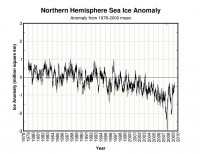
It has returned to very near the 1979-2000 year average (NSIDC). Had NSIDC used the entire period of record as their base period (1979-2008), we would be at or above the average.
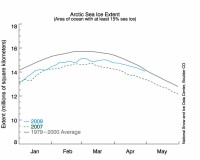
The most competent polar scientific organization, Arctic and Antarctic Research Institute (AARI) in St. Petersburg, Russia published recently 3 books summarizing scientific results of climate changes in the Arctic region for the last century. One of it dedicated to Arctic climate. Based on the results obtained they forecast coming temperature and sea ice cover area changes in the Polar seas for the next 10-20 years.
Anomaly of mean annual air surface temperature 1900-2006 in the zone of 70-90 N and its predicted trend (I.E.Frolov et al. Scientific research in Arctic. Vol. 2. Climatic changes in the ice cover of the Eurasian shelf seas. -SPb.: “Nauka”, 2007,158 p).
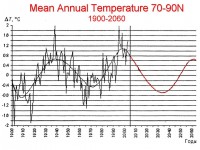
See large image here.
The authors showed that Arctic climate change is natural in origin and several orders of magnitude greater than the level of anthropogenic impact on the climate. Estimates of possible changes of Arctic air temperature and ice cover propagation area for the 21st century are given on a basis of the revealed stable cyclic oscillations of 10, 20 and 50 to 60 years. Read more here.
The IJIS JAXA AMSR-E data shows we are running higher than any of the years since 2002.
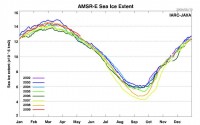
Apr 29, 2009
Inconvenient Eisdicken - “surprising results” from the Arctic
By Anthony Watts, Watts Up With That
This is a news story from Germany outlining another Arctic ice measurement expedition. This one was conducted by flying the scientists across the north polar ice cap using the WWII era workhorse Douglas DC-3 airplane equipped with skis, and towing an airborne sounder twenty meters above the ice surface. It makes the Catlin Arctic Ice Survey look rather pointless, but then we knew that. BTW “Eisdicken” translates to “ice thickness”. - Anthony
Surprising Results: At the North Pole ice sheet is thicker than expected.
The research aircraft Polar 5 ended today in Canada’s recent Arctic expedition. During the flight, researchers have measured the current Eisstärke measured at the North Pole, and in areas that have never before been overflown. Result: The sea-ice in the surveyed areas is apparently thicker than the researchers had suspected.
Normally, ice is newly formed after two years, over two meters thick. “Here were Eisdicken up to four meters,” said a spokesman of Bremerhaven’s Alfred Wegener Institute for Polar and Marine Research. For scientists, this result is still in contradiction to the warming of the seawater.
Besides the Eisdicken was also the composition of the air are investigated. With the help of a laser, the researchers reviewed how polluted the atmosphere by emissions from industrialized countries. On the expedition, some 20 scientists from the U.S., Canada, Italy and Germany.
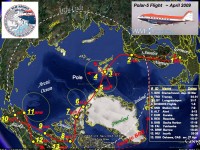
An ice thickness probe, the so-called EM-Bird, which is usually dragged below a helicopter, is now operated for the first time by a fixed-wing aircraft. The EM-Bird is towed under the hull of the aircraft by means of a winch for take-off and landing. For the surveys, the probe is towed on an 80 m long rope twenty metres above the ice surface. More extensive areas can now be investigated due to the longer range of the aircraft in comparison to a helicopter.
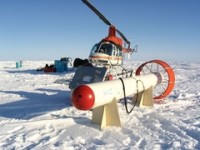
UPDATE: more on the EM-Bird probe (h/t to Ron de Haan)
Electromagnetic (EM) induction sounding for ice thickness measurements is a technique that can achieve long profiles of some kilometer length. The accuracy and robustness of the EM method has been evaluated by comparing coincident drill-hole and EM measurements. Read more (Poster, pdf, size: 156 kB). Sure beats hauling a sledge and a broken home-built ice radar around doesn’t it? Read more and see comments on this successful scientific expedition here and the other PR driven, BBC hyped but failed Catlin expedition that is likely reaching an end 542 km short of their goal with failed equipment and frostbite and in a blizzard here. Do expect a press release touting a successful Catlin mission carried by the BBC.
Here by the way is the latest NSIDC ice trace approaching the normal.
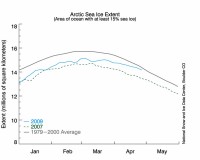
And finally note we continue to track ahead of all the years in the AMSR-E record (starting in 2002) in the IJIS-JAXA web site here.
|















